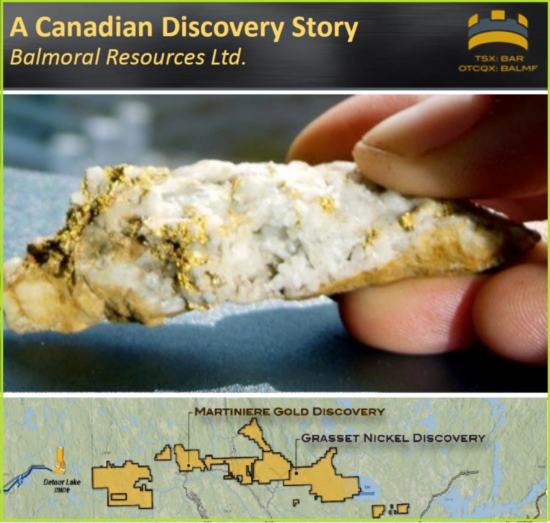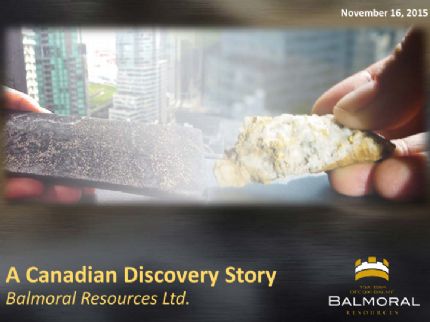 Intersects 57.88m @ 1.85% Ni, 0.21% Cu, 0.40 g/t Pt and 0.97 g/t Pd, Showing Highest Grade To Date
Intersects 57.88m @ 1.85% Ni, 0.21% Cu, 0.40 g/t Pt and 0.97 g/t Pd, Showing Highest Grade To Date
Vancouver, Nov 26, 2014 AEST (ABN Newswire) - Balmoral Resources Ltd. ("Balmoral" or the "Company") ( TSE:BAR) (
TSE:BAR) ( BALMF:OTCMKTS) reported results for an additional 12 holes testing the Horizon 3 nickel-copper-PGE discovery on the Company's wholly owned Grasset Property in Quebec. In addition to extending the Horizon 3 sulphide zone to a depth of 350 vertical metres, today's results continue to feature broad intervals of nickel sulphide mineralization throughout the discovery area and include the highest grade intercept to date from Grasset. Hole GR-14-57 returned a very broad Horizon 3 intercept of 57.88 metres grading 1.85% Ni, 0.21% Cu, 0.40 g/t Pt and 0.97 g/t Pd, which includes a high-grade interval of 20.63 metres grading 3.47% Ni, 0.40% Cu, 0.79 g/t Pt and 1.92 g/t Pd. This high grade interval is capped by, and includes, a previous reported 1.51 metre thick interval of massive sulphide which returned 14.96% Ni, 0.74% Cu, 3.03 g/t Pt and 5.61 g/t Pd - further emphasizing the very high nickel tenure of the Horizon 3 sulphide mineralization.
BALMF:OTCMKTS) reported results for an additional 12 holes testing the Horizon 3 nickel-copper-PGE discovery on the Company's wholly owned Grasset Property in Quebec. In addition to extending the Horizon 3 sulphide zone to a depth of 350 vertical metres, today's results continue to feature broad intervals of nickel sulphide mineralization throughout the discovery area and include the highest grade intercept to date from Grasset. Hole GR-14-57 returned a very broad Horizon 3 intercept of 57.88 metres grading 1.85% Ni, 0.21% Cu, 0.40 g/t Pt and 0.97 g/t Pd, which includes a high-grade interval of 20.63 metres grading 3.47% Ni, 0.40% Cu, 0.79 g/t Pt and 1.92 g/t Pd. This high grade interval is capped by, and includes, a previous reported 1.51 metre thick interval of massive sulphide which returned 14.96% Ni, 0.74% Cu, 3.03 g/t Pt and 5.61 g/t Pd - further emphasizing the very high nickel tenure of the Horizon 3 sulphide mineralization.
Reported intercepts also begin to demonstrate the continuation of high-grade nickel sulphide mineralization to the northwest of the previously intersected fault/disruption corridor (Figure 2). Strong Horizon 3 intercepts are reported from holes GR-14-54 (including 3.82 metres grading 4.01% Ni within a broader mineralized intercept (see below)), GR-14-60 which returned 33.80 metres grading 1.44% Ni, 0.17% Cu, 0.31 g/t Pt and 0.80 g/t Pd and GR-14-56 which features a 0.85 metre, fault bound, massive sulphide intercept which returned 10.58% Ni, 1.23% Cu, 2.49 g/t Pt and 6.41 g/t Pd. (see Figure 1, Figure 2 and Figure 3 in link below).
"Today's results continue to demonstrate the broad widths and very high nickel-PGE tenure of the Horizon 3 sulphide zone and expand the discovery to depth were it remains open" said Darin Wagner, President and CEO of Balmoral. "Results from an additional 8 holes are expected before year end and we look forward to an exciting year ahead as we continue the delineation of the Horizon 3 discovery and begin the process of evaluating the balance of the Grasset Ultramafic Complex ("GUC") for additional zones of nickel-copper-PGE mineralization."
Reported drill intercepts have now traced the Horizon 3 discovery to a vertical depth of 350 metres and for a similar distance along strike. The upper portion of the Horizon 3 sulphide zone in Hole GR-14-59 was terminated/removed by the Porphyry Fault. This hole confirms a southerly dip to the fault, as indicated on Figure 2, with the fault block hosting the bulk of the intercepts to date broadening at depth. Hole GR-14-55 may have intersected a fault, which is currently interpreted to terminate the lower contact of the mineralized intervals in holes GR-14-22 and -23 located to the northwest. Additional drilling will be required to evaluate this interpretation and the orientation and offset on this feature.
Hanging Wall Gold Mineralization
Drilling continues to intersect a number of intervals of anomalous to locally high-grade gold mineralization, developed in sheared and strongly altered volcanic rock in the hanging wall to, or within the uppermost portion of, the Grasset Ultramafic Complex ("GUC") (see Table 2 below). Gold mineralization occurs in quartz+/-carbonate veins within a sequence of sericite-carbonate-fuchsite-silica altered mafic and felsic volcanic rocks immediately in the hanging wall to the GUC or in isolated quartz-carbonate-talc veins cutting the GUC. Results from the holes released include an intercept grading 14.12 g/t gold over 1.90 metres in drill hole GR-14-58. Similar high-grade gold mineralization occurs at the Company's Fenelon gold zone located 6 kilometres to the west of the area currently being tested. The gold mineralization at Fenelon is also associated with quartz-carbonate veins hosted by, or proximal to, an ultramafic sill interpreted as part of the GUC.
Drilling will resume at Grasset in early 2015 with a goal of further delineating the Horizon 3 discovery and testing a number of promising targets elsewhere in the GUC. The Company will provide additional details on its recently completed low-level Mag/EM survey over the entirety of the GUC and surrounding areas as results and interpretations are completed.
QP and Quality Control
Mr. Darin Wagner (P.Geo.), President and CEO of the Company, is the non-independent qualified person who has approved the scientific and technical information contained in this news release. Mr. Wagner has supervised the work programs on the Grasset Property, visited the property on multiple occasions, has examined the drill core or photos of same from the holes summarized in this release, reviewed the results with senior on-site geological staff and reviewed the available analytical and quality control results.
Balmoral employs a quality control program for all of its drill programs, to ensure best practice in the sampling and analysis of drill core. This includes the insertion of blind blanks, duplicates and certified standards into the sample stream. NQ-sized drill core is saw cut with half of the drill core sampled at intervals based on geological criteria including lithology, visual mineralization and alteration. The remaining half of the core is stored on-site at the Company's Fenelon field camp in Central Quebec. Drill core samples are transported in sealed bags to ALS Minerals Val d'Or, Quebec analytical facilities.
Base metal analyses were initially obtained via ICP-AES with both Aqua Regia and 4 Acid digestion employed. The two digestion methods show good correlation. Nickel values in excess of 10,000 ppm are reanalyzed using a sodium peroxide fusion followed by ICP-AES finish. PGE values were obtained via industry standard fire assay with ICP-AES finish using 30 g aliquots. Gold analyses are obtained via industry standard fire assay with atomic absorption finish using 30 g aliquots. For samples returning greater than 5.00 g/t gold follow-up fire assay analysis with a gravimetric finish is completed. The Company has also requested that any samples returning greater than 10.00 g/t gold undergo screen metallic fire assay.
Following receipt of assays, visual analysis of mineralized intercepts is conducted and additional analysis may be requested. ALS Minerals is ISO 9001:2008 certified and the Val d'Or facilities are ISO 17025 certified for gold analysis. The Company has contracted an independent quality control expert to supervise its QA/QC program.
To view tables and figures, please visit:
http://media.abnnewswire.net/media/en/docs/78784-TSE-BAR-20141126.pdf
About Balmoral Resources Ltd
 Balmoral Resources Ltd. (
Balmoral Resources Ltd. ( TSE:BAR) (
TSE:BAR) ( OTCMKTS:BALMF) is a Canadian-based discovery company focused on high-grade nickel and gold discoveries on its wholly owned, 700+ square kilometre Detour Trend Project in Quebec, Canada. With a philosophy of creating value through the drill bit and a focus on proven productive precious/base metal belts, Balmoral is following an established formula with a goal of maximizing shareholder value through discovery and definition of high-grade, Canadian base metal and gold assets.
OTCMKTS:BALMF) is a Canadian-based discovery company focused on high-grade nickel and gold discoveries on its wholly owned, 700+ square kilometre Detour Trend Project in Quebec, Canada. With a philosophy of creating value through the drill bit and a focus on proven productive precious/base metal belts, Balmoral is following an established formula with a goal of maximizing shareholder value through discovery and definition of high-grade, Canadian base metal and gold assets.



![abnnewswire.com]()
Related Companies
Social Media
Share this Article

 TSE:BAR) (
TSE:BAR) ( BALMF:OTCMKTS) reported results for an additional 12 holes testing the Horizon 3 nickel-copper-PGE discovery on the Company's wholly owned Grasset Property in Quebec. In addition to extending the Horizon 3 sulphide zone to a depth of 350 vertical metres, today's results continue to feature broad intervals of nickel sulphide mineralization throughout the discovery area and include the highest grade intercept to date from Grasset. Hole GR-14-57 returned a very broad Horizon 3 intercept of 57.88 metres grading 1.85% Ni, 0.21% Cu, 0.40 g/t Pt and 0.97 g/t Pd, which includes a high-grade interval of 20.63 metres grading 3.47% Ni, 0.40% Cu, 0.79 g/t Pt and 1.92 g/t Pd. This high grade interval is capped by, and includes, a previous reported 1.51 metre thick interval of massive sulphide which returned 14.96% Ni, 0.74% Cu, 3.03 g/t Pt and 5.61 g/t Pd - further emphasizing the very high nickel tenure of the Horizon 3 sulphide mineralization.
BALMF:OTCMKTS) reported results for an additional 12 holes testing the Horizon 3 nickel-copper-PGE discovery on the Company's wholly owned Grasset Property in Quebec. In addition to extending the Horizon 3 sulphide zone to a depth of 350 vertical metres, today's results continue to feature broad intervals of nickel sulphide mineralization throughout the discovery area and include the highest grade intercept to date from Grasset. Hole GR-14-57 returned a very broad Horizon 3 intercept of 57.88 metres grading 1.85% Ni, 0.21% Cu, 0.40 g/t Pt and 0.97 g/t Pd, which includes a high-grade interval of 20.63 metres grading 3.47% Ni, 0.40% Cu, 0.79 g/t Pt and 1.92 g/t Pd. This high grade interval is capped by, and includes, a previous reported 1.51 metre thick interval of massive sulphide which returned 14.96% Ni, 0.74% Cu, 3.03 g/t Pt and 5.61 g/t Pd - further emphasizing the very high nickel tenure of the Horizon 3 sulphide mineralization.  Balmoral Resources Ltd. (
Balmoral Resources Ltd. ( TSE:BAR) (
TSE:BAR) ( OTCMKTS:BALMF) is a Canadian-based discovery company focused on high-grade nickel and gold discoveries on its wholly owned, 700+ square kilometre Detour Trend Project in Quebec, Canada. With a philosophy of creating value through the drill bit and a focus on proven productive precious/base metal belts, Balmoral is following an established formula with a goal of maximizing shareholder value through discovery and definition of high-grade, Canadian base metal and gold assets.
OTCMKTS:BALMF) is a Canadian-based discovery company focused on high-grade nickel and gold discoveries on its wholly owned, 700+ square kilometre Detour Trend Project in Quebec, Canada. With a philosophy of creating value through the drill bit and a focus on proven productive precious/base metal belts, Balmoral is following an established formula with a goal of maximizing shareholder value through discovery and definition of high-grade, Canadian base metal and gold assets.








